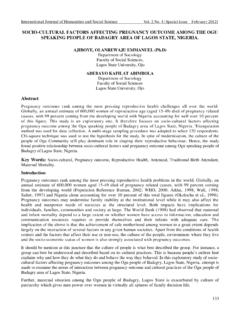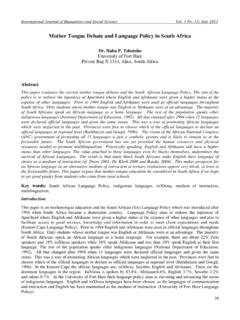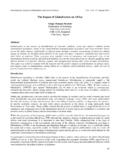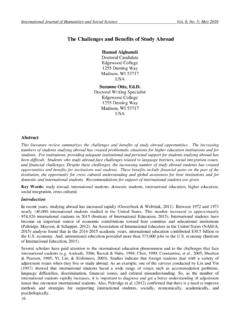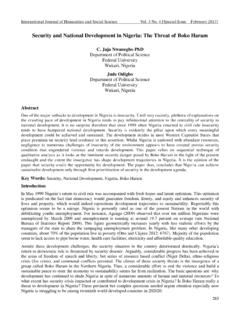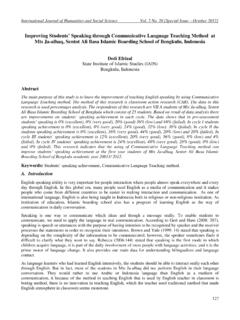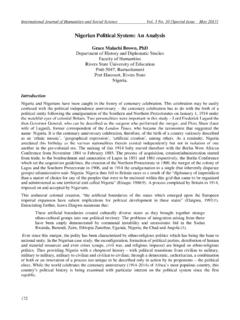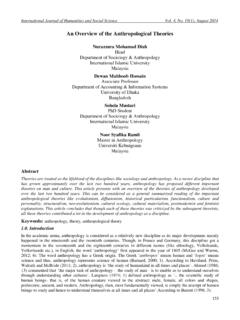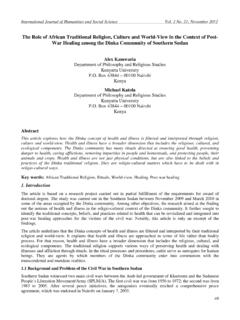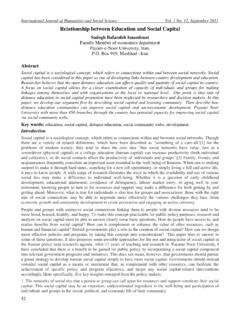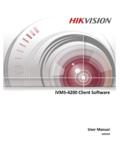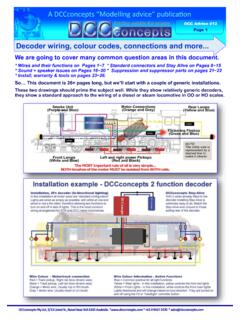Transcription of COMMUNICATION TRAINING MODULE - ijhssnet.com
1 International Journal of Humanities and Social Science Vol. 1 No. 20; December 2011 231 COMMUNICATION TRAINING MODULE DR. HELLEN K. MBERIA JOMO KENYATTA UNIVERSITY OF AGRICULTURE AND TECHNOLOGY SCHOOL OF HUMAN RESOURCE FOR DEVELOPMENT DEPARTMENT OF SOCIAL SCIENCES AND HUMANITIES INTROUDUCTION Importance of COMMUNICATION has always been realized in all times because it is the most vital means by which people are connected together in society. However, today COMMUNICATION plays a crucial role in almost all aspects of life. Work in business, government or organizations are impossible without COMMUNICATION . People have to communicate with each other, exchange information, make decisions and talk about innovations. Management is a complex practice of communicating with other people.
2 In an age when the business environment is turbulent in terms of competition, new technologies political instability, workforce diversity, the need for good COMMUNICATION skills is being increasingly felt by mangers at all levels. The ability to communicate effectively in various business situations has to be developed. For organization to perform and to have a competitive advantage managers and workers have to be well equipped with COMMUNICATION skills. Many of the problems that occur in an organization are the direct result of people failing to communicate effectively and efficiently. Big corporations textile sector and multinational organizations need better COMMUNICATION skills in their employees so that they are able to work in teams and with people from diverse background.
3 Good COMMUNICATION skills in today s business world, has been found to directly impact productivity. Therefore, this COMMUNICATION skills TRAINING MODULE will help to improve COMMUNICATION among the managers and workers for enhanced, competitive and successful performance of the organization. Aims and objectives of the MODULE Aim The aim of this MODULE is to assist in the development of COMMUNICATION competence by providing information regarding different forms of COMMUNICATION and their appropriate use. Learning outcomes By the end of this program, participants will be able, to communicate more effectively and efficiently by: i. Listening, and responding with an open mind in a more effective way. ii. Using appropriate COMMUNICATION methods. iii. Minimizing COMMUNICATION barriers. iv. Using verbal and non-verbal messages appropriately.
4 V. Relating and networking with others at work. vi. Giving and receiving instruction correctly vii. Maintaining a working relationship with clients. viii. Use of two-way COMMUNICATION feedback. ix. Recognize and appreciate cultural and gender difference in COMMUNICATION . TRAINING TOPICS A. Understanding COMMUNICATION What is COMMUNICATION The COMMUNICATION process Principles of COMMUNICATION B. Barriers to COMMUNICATION Over COMMUNICATION Long, differences Conflicting information Interests and attitudes Differing status, position and self-expression Exercise/activity The Special Issue on Contemporary Research in Social Science Centre for Promoting Ideas, USA 232 C. Listening skills Difference between listening and leaving. Types of listening Why you need good listening skills Good listening practices.
5 D. Providing feedback Giving feedback Characteristics of good feedback Activity E. Non-verbal COMMUNICATION Types Functions Characteristics Activity F. Giving and receiving instructions Give clear instructions \ Use a structured approach Receive and follow instructions Activity G. Oral COMMUNICATION Face to face Conducting meetings H. Adapting to differences: Personality, Culture, and Gender TEACHING METHODOLOGIES Lectures Group discussions and reporting Group activities (These activities can be done before , during or after the presentation of the topic) INSTRUCTIONAL MATERIAL LCD Laptops Note books, etc Understanding COMMUNICATION at workplace Learning outcomes - To understand the process necessary for effective COMMUNICATION . - To identify barriers and situations that can inhibit effective COMMUNICATION - To identify and use techniques of active listening.
6 Definition COMMUNICATION is the act of being understood. COMMUNICATION is a process, which involves sharing of information between people through a continuous activity of speaking listening, and understanding. Or It is the giving receiving, or exchange of information opinions or ideas by writings, verbally, non-verbally visual means, or any combination of the three, so that the material communicated is completely understood by everyone concerned. Importance of COMMUNICATION Many writers have identified the advantages of good COMMUNICATION : 1. Leads to personal effectiveness. 2. Helps to network with people. 3. Influences motivation for enhanced performance. International Journal of Humanities and Social Science Vol. 1 No. 20; December 2011 233 4. Builds better understanding between boss and subordinates. 5.
7 Creates better interpersonal relations. 6. Increases listening ability. All these benefits cannot be automatically achieved. One can understand the complex nature of COMMUNICATION by examining the factors that make COMMUNICATION a dynamic process. The COMMUNICATION process The word process indicates that it is an activity that is connected with a series of steps that are deliberately undertaken to reach a goal. A COMMUNICATION process comprises the following elements: What is involved in the COMMUNICATION process? The steps involved in this process are: 1. Idea: Information exists in the mind of the sender (who is the source). This can be a concept, idea, information, or feelings. 2. Encoding: The source initiates a message by encoding the idea (or a thought) in words or symbols and sends it to a receiver. The message is the actual physical product from the source encoding.
8 When we speak, the speech is the message. When we write, the writing is the message. When we gesture, the movements of our arms and the expressions of our faces are the message. 3. The Channel: The channel in the COMMUNICATION process is the medium that the sender uses to transmit the message to the receiver. Care needs to be exercised in selecting the most effective channel for each message. Even though both an oral and a written medium may be appropriate to transmit a particular message, one medium may be more effective than the other. To illustrate, let s assume that an individual desires an immediate reply to a question. Although the message could be in either an oral or a written form, the oral medium most likely will be more effective because of the immediacy, if required. In selecting an appropriate channel, the sender must assess the following factors, as the situation demands: -need for immediate transmission of message, (Fax instead of letter) -need for immediate feedback, (Phone instead of fax) -need for permanent record of the message, (Written rather than oral) -degree of negotiation and persuasion required, (Personal meeting face-to face) -the destination of the message, and (Far flung area letter only) -the nature of the content of the message.
9 (Has to be a contract written) In addition, the sender should take into consideration his/her skill in using each of the alternative channels, as well as the receiver s skill in using each of the channels. COMMUNICATION rarely takes place over only one channel; two or three even four channels are normally used simultaneously. Example: in face-to-face interactions, we speak and listen but we also gesture and receive these signals visually. The Special Issue on Contemporary Research in Social Science Centre for Promoting Ideas, USA 234 4. Decoding: It is the act of understanding messages (words or symbols). This is known as the sound waves are translated into ideas, we are taking them out of the code they are in, hence decoding. Thus, listeners and readers are often regarded as Decoders.
10 During the transmitting of the message, two processes will be received by the receiver. Content and Context. Content is the actual words or symbols of the message which is known as language spoken and written words combined into phrases that make grammatical and semantic (meaning) sense. We all use and interpret the meanings of words differently, so even simple messages can be misunderstood (Are yougoing to give me or not?). And many words have different meanings to confuse the issue even more (You are smart.). Context is the environment in which COMMUNICATION takes place. It can be formal or informal. The circumstances surrounding the COMMUNICATION also make up the context. Remember: A message is never communicated unless it is understood by the receiver. Question arises then, how do you know a message has been properly received? 5.
